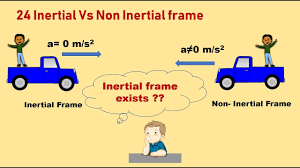

Introduction:
In the realm of physics, the idea of frames of reference assumes a principal part in portraying the movement of items. Two normal kinds of casings are inertial and non-inertial edges. These casings give alternate points of view to investigating the elements of articles and are pivotal for precisely understanding and anticipating their way of behaving. In this article, we will investigate the qualities of inertial and non-inertial frames, their key distinctions, and give important equations and guides to delineate their applications.
Inertial Frames:
An inertial frame of reference is a direction framework wherein Newton's most memorable law of movement turns out as expected. As per this regulation, an item very still remaining parts very still, and an item moving keeps moving at a steady speed, in an orderly fashion, except if followed up on by an external force. At the end of the day, in an inertial edge, an article's movement is resolved exclusively by the forces following up on it, with no intrinsic speed increase or imaginary forces included.
In an inertial force, we can utilize Newton's laws of movement to portray the way of behaving of articles. The formulas related with these regulations, like F = ma (Newton's subsequent regulation) and F = G(m1m2/r^2) (law of general attraction), are relevant in inertial frames.
Example: Consider a vehicle going at a consistent speed along a straight street. According to the viewpoint of a spectator inside the vehicle, the movement seems smooth and unsurprising. This edge of reference is inertial on the grounds that the eyewitness seems no forces following up on objects inside the vehicle. The laws of movement precisely depict the vehicle's way of behaving.
Non-Inertial Frames:
A non-inertial frame of reference is a direction framework wherein Newton's most memorable law of movement doesn't turn out as expected. In such cases, extra forces, known as made up or inertial forces, should be acquainted with represent the clear speed increase of items. These imaginary forces emerge because of the speed increase or revolution of the actual edge and are not brought about by any actual connection.
Common examples o non-inertial frames incorporate turning frames, speeding up endlessly frames encountering centripetal or centrifugal forces. In these casings, extra forces are considered to make sense of the noticed movement.
To appropriately dissect movement in non-inertial frames, extra terms are added to Newton's second law of movement. These terms represent the inertial forces and are intended for the kind of non-inertial frame viable. Instances of such terms incorporate the diffusive force, Coriolis force, and Euler force.
Example: We should envision a traveler inside a turning carnival ride. According to the point of view of the traveler, they experience a centrifugal force pushing them outward. In this rotating frame, the laws of movement would should be adjusted to incorporate the imaginary centrifugal force term, considering exact expectations of the traveler's movement.
Key Differences between Inertial and Non-Inertial Frames:

